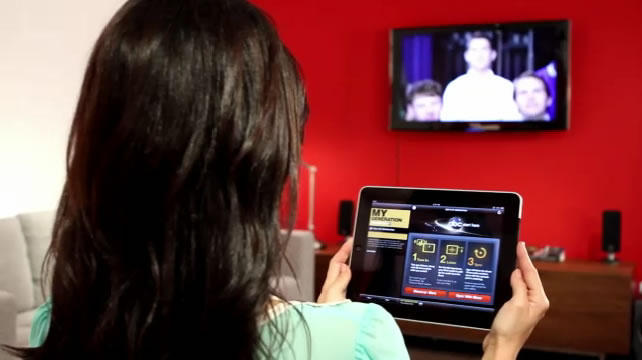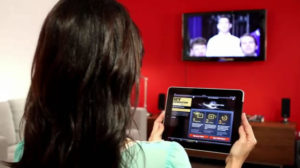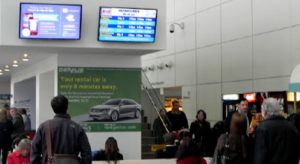
Social TV Is Interesting, But Is It The Answer?
March 23, 2012 by Dave Haynes
 There have been a pair of lengthy posts in the last 24 hours – manifestos, of sorts, on the wobbly state of the Digital Out Of Home space and calls for the industry to start thinking about Digital OOH being more aptly framed as Social TV.
There have been a pair of lengthy posts in the last 24 hours – manifestos, of sorts, on the wobbly state of the Digital Out Of Home space and calls for the industry to start thinking about Digital OOH being more aptly framed as Social TV.
rVue and its founder Jason Kates issued a lengthy argument that Social TV is where it’s going to be at, run in an email blast and here as a guest post.This morning, Ken Goldberg posted his thoughts about the necessary shift away from the current ad-based network path to one that gets this ad medium at the big boy table with TV and the cool online kids.
Where I can agree, certainly, is that very few Digital OOH ad networks see their account executives using the available inventory look-up tools in their software management systems. They don’t need to, because there’s ALWAYS available inventory on their networks.
But I am not sure they are struggling or failing, and could turn them around, by getting more social. Many of the networks are struggling because they never should have been there in the first place, or if there was a genuine media opportunity, it was wasted with weak strategy or bad compromises.
Many or most Digital OOH networks will fail because they tried to create a medium, and ran up the capital and operating costs to do so, in places that aren’t well-suited to media models. Or if they were genuine media environments, where their screens were second or third fiddle in terms of media placement.

Consider this photo I saw this morning in DailyDOOH, for the latest company trying to make an ad buck marketing digital screens to people who take the ferry across the Hudson and into Manhattan. The premium ad position is being used by a piece of printed vinyl graphic. Waaaay up high above that is the digital screen. If you can’t have the viewing positions that are in the natural line of sight of people, don’t start. We’ve seen a variation of this image for a dozen years or more, over and over.
A lot of networks are failing even if they have good positions in their venues because their content is terrible and so is their creative. The product is what’s on the screen, not the screen.
And a lot of networks fail because the backers went in thinking this would be easy – how hard could it be to sell advertising??? – and by the time they learned ALL that they needed to learn, they’d run low on start-up capital and weren’t seeing anywhere near the ad revenues they’d spreadsheeted. So they couldn’t expand to a size that made them relevant to people who control “real” media budgets.
The Digital OOH sector does not, in short, have a technology problem. It has an end user problem.
Most of the truly smart software and hardware guys in this sector spend little or no time pursuing third-party Digital OOH business opportunities, and focus their energies on projects that will not succeed or fail based on ad revenues. They definitely do have time for chats with established media companies because those deals, in most respects, are conversions of existing analog “faces” to digital. Those mediacos are just upgrading something established and generating money.
I think, with some exceptions like condition-specific medical networks and really well defined business and consumer environments, most of the future of Digital OOH as we know it is the conversion of poster faces. There are millions and millions of them.
The unquestionably interesting proposition by rVue and followed on by Ken is that the Digital OOH sector should embrace social media, making screens in public spaces the third leg of the stool propped up by TV and mobile/smart devices. Ken writes thoughtfully, as always, about how social TV could play out:
Imagine extending the reach of a TV program or ad campaign through the integration of social media tools and apps with networks of out of home screens, perhaps augmented by special benefits, offers or rewards to keep engagement high. Would a Revenge fan make his/her way to an out-of-home network venue to check in and thereby receive a preview or clue as to what Emily Thorne is up to next week? Would a brand want to reward consumers who like (in both the Webster and Facebook definitions of the word) their product online, on TV and in the store? Would a TV network want to engage in a second screen dialogue with viewers outside the home, to be continued on a second screen while the show airs (or vice versa)? If the answers are yes, then DOOH becomes immensely relevant when it joins the Social TV ecosystem.
I think we’re a long way from the answer being “Yes” and very much in a world of “Well, maybe…”
Social and mobile are huge and culture-shifting technologies, no doubt, but the numbers of “game-changing” technologies and apps that have already risen up and faded is crazy. Just think about the number of killer applications that Google has unveiled and then mothballed or scaled back. Just think how much noise was generated by check-in start-ups, and how often you struggled to figure out why you or anyone would care.
What we do know is that many consumers already have, and most consumers will soon have, screen devices with the computing power and connectivity of laptops in their hands on the couch and just about wherever they go. They have the ability to whip them out at any time, and engage with what they see on a screen because it’s interesting, relevant or rewarding.
Or they can whip them out and do a bazillion other things, because whatever they’re seeing on the Digital OOH screens is irrelevant or boring. Community and crowd-sourced commentary can be fun, but anyone who’s tried following hash tag-based conversations on a broadcasting “event” will know one in maybe 10 Tweets (generously) are good and the rest is crap gleefully keyed in by people with the most fleeting command of language or grammar basics.
That, to me, is the big challenge of transforming Digital OOH into Social TV. Engaging in a social conversation has to be the best option and experience. Not JUST an option for consumers.
Much of Digital OOH just flat ain’t working. But I’d be really cautious in thinking social integration is the way forward.
Top Image: Second Screen



Dave:
Great and thoughtful post.
I think what we are suggesting is a content and engagement strategy that veers from the simple “eyeballs on screens” meme that exists today. Making Digital Ooh an extension of Social TV has to be more than check-ins and twitter walls. There needs to be true multi-screen engagement: engagement that started online and/or at home via TV. That’s the attraction to the brands and networks. As I said, it isn’t baked yet, but the tools on the Social TV side are advancing daily and attracting more users. We’ll find out in the next little while if we can get some mindshare and attraction for the 300 million-plus impressions we dish up as an industry every day. It is certainly fair to question whether the time is now, or even if it makes sense. But I think the question has to be asked and the boundaries challenged.